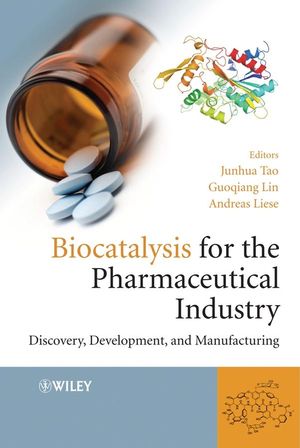Biocatalysis for the Pharmaceutical Industry: Discovery, Development, and ManufacturingISBN: 978-0-470-82314-9
Hardcover
250 pages
October 2008
 |
||||||
1 Enzymes and Their Synthetic Applications: An Overview.
1.1 Introduction.
1.2 Enzyme Families.
1.3 Enzyme Discovery and Optimization.
1.4 Enzyme Production.
1.5 Enzymes and Synthetic Applications.
1.5.1 Ketoreductases (EC 1.1.1.2).
1.5.2 Enoate Reductases or Ene Reductases (EC 1.3.1.16).
1.5.3 Oxygenases (EC. xxxx).
1.5.4 Alcohol Oxidases (EC 1.1.3.X).
1.5.5 Peroxidases (EC 1.11.1.X).
1.5.6 Halogenases (EC. xxxx).
1.5.7 Nitrilases (EC 3.5.5.1).
1.5.8 Nitrile Hydratases (EC 4.2.1.84).
1.5.9 Epoxide Hydrolases (EC 3.3.2.X).
1.5.10 !-Transaminases (EC 2.6.1.X).
1.5.11 Hydroxynitrile Lyases (EC 4.1.2.X).
1.5.12 Aldolases (EC. xxxx).
1.5.13 Glycosidases (EC. xxxx).
1.5.14 Glycosyltransferase (EC. xxxx).
1.6 Conclusions.
2 Expression Hosts for Enzyme Discovery and Production.
2.1 Introduction.
2.2 How to Choose an Expression System.
2.3 Prokaryotic Expression Systems.
2.3.1 Posttranslational Modification in Prokaryotes.
2.3.2 Escherichia coli.
2.3.3 Bacilli.
2.3.4 Pseudomonas fluorescens.
2.3.5 Other Prokaryotic Expression Systems.
2.4 Eukaryotic Expression Systems.
2.4.1 Yeasts.
2.4.2 Filamentous Fungi.
2.4.3 Insect/Baculovirus System.
2.4.4 Mammalian Cell Cultures.
2.4.5 Other Expression Systems.
2.5 Cell-Free Expression Systems.
2.6 Conclusions.
3 Directed Enzyme Evolution and High-Throughput Screening.
3.1 Introduction.
3.2 Directed Evolution Library Creation Strategies.
3.2.1 Random and Semi-Rational Mutagenesis.
3.2.2 Gene Shuffling.
3.3 Directed Evolution Library Screening/Selection Methods.
3.3.1 In Vivo Methods: Genetic Complementation.
3.3.2 In Vivo Methods: Chemical Complementation.
3.3.3 In Vivo Methods: Surface Display.
3.3.4 In Vitro Methods: Lysate Assay.
3.3.5 In Vitro Methods: Ribosome Display.
3.3.6 In Vitro Methods: In Vitro Compartmentalization.
3.3.7 Equipment/Automation.
3.4 Selected Industrial Examples.
3.4.1 Activity.
3.4.2 Thermostability.
3.4.3 Substrate Specificity.
3.4.4 Product Specificity.
3.4.5 Enantioselectivity.
3.5 Conclusions and Future Directions.
4 Applications of Reaction Engineering to Industrial Biotransformations.
4.1 Introduction.
4.2 Metabolic Bioconversion.
4.3 Enzymatic Biotransformations.
4.3.1 Cofactor Regeneration.
4.3.2 Racemic Mixtures.
4.3.3 Equilibrium Conversion.
4.3.4 By-Product Formation.
4.3.5 Substrate Inhibition.
4.3.6 Low Solubility.
4.4 Conclusions.
5 Chiral Synthesis of Pharmaceutical Intermediates Using Oxynitrilases.
5.1 Introduction.
5.2 HNL.
5.2.1 The Natural Function and Distribution of HNLs.
5.2.2 Classification of HNLs.
5.2.3 New HNLs and High-Throughput Screening.
5.3. Reaction of HNLs.
5.3.1 Reaction System.
5.3.2 Immobilization of Enzyme.
5.3.3 Continuous Reactors.
5.3.4 Henry Reaction.
5.4 Transformation of Cyanohydrins.
5.4.1 Transformation of Hydroxyl Group.
5.4.2 Transformation of Nitrile Group.
5.4.3 Intramolecular Reaction.
5.5 Summary.
6 Expanding the Scope of Aldolases as Tools for Organic Synthesis.
6.1 Directed Evolution and Rational Mutagenesis.
6.2 Reaction Engineering.
6.3 Broad Substrate Tolerance of Wild-Type Aldolases.
6.4 Conclusions.
7 Synthetic Applications of Ketoreductases and Alcohol Oxidases.
7.1 Ketoreductases.
7.1.1 Wild-Type Whole-Cell Biocatalysts.
7.1.2 Recombinant Whole-Cell Biocatalysts Overexpressing Catalytic Enzymes.
7.1.3 Isolated Enzyme.
7.2 Alcohol Oxidases.
7.2.1 Primary Alcohol Oxidases.
7.2.2 Secondary Alcohol Oxidases.
8 Applications of Nitrile Hydratases and Nitrilases.
8.1 Introduction.
8.2 NHase.
8.2.1 New NHases.
8.2.2 Applications.
8.3 Nitrilase.
8.3.1 New Nitrilases.
8.3.2 Applications.
8.4 Conclusions.
9 Biosynthesis of Drug Metabolites.
9.1 Introduction.
9.2 Metabolite Synthesis Using Mammalian Bioreactors.
9.2.1 Selection of In Vitro Systems.
9.2.2 Reaction Condition Optimization.
9.2.3 Large Scale Incubations.
9.2.4 Examples with Mammalian Bioreactors.
9.2.5 In Vivo Samples.
9.3 Metabolite Synthesis Using Microbial Bioreactors.
9.3.1 Microbial Bioreactors Used in Metabolite Structure Elucidation.
9.3.2 Microbial Bioreactors Used in Synthesis of Key Metabolites.
9.3.3 Strain Selection.
9.3.4 Microbial Glycoside Conjugation.
9.3.5 Large Scale Reactions.
9.3.6 Examples for Metabolite Synthesis with a Microbial Bioreactor.
9.4 Recombinant Enzyme Bioreactors.
9.4.1 Advantages of Using CYP Enzymes for Producing Drug Metabolites.
9.4.2 Human Cytochrome Biocatalysts.
9.4.3 Microbial CYP Enzymes.
9.5 Summary.
10 Application of Whole-Cell Biotransformation in the Pharmaceutical Industry.
10.1 Introduction.
10.1.1 Whole-Cell Biotransformation Processes Used in Commercial Production of Pharmaceuticals.
10.1.2 Application of Whole-Cell Biotransformation Process in the Synthesis of Chiral Pharmaceutical Intermediates.
10.2 Disadvantages of Whole-Cell Process Compared with the Isolated Enzyme Process.
10.2.1 Substrate Availability and Recovery of Products in Low Concentrations.
10.2.2 Undesirable Side Reactions.
10.2.3 Toxicity of Substrate and Product.
10.3 Advantages of Whole-Cell Process Compared with the Isolated Enzyme Process.
10.3.1 More Stable Sources than Isolated Enzymes.
10.3.2 Regeneration of Cofactors and Multi-Enzymes Reactions.
10.3.3 Diversity and Availability.
10.3.4 Reactions with Non-Commercially Available Isolated Enzymes for Preparative Scale Synthesis.
10.3.5 Cost Effectiveness and Ease of Operation.
10.4 Approaches to Address the Disadvantages of Whole-Cell Biotransformation.
10.4.1 Control of Substrate and Product Concentration by Absorbing Resins.
10.4.2 Immobilized-Cell Technology.
10.4.3 Aqueous–Organic Two-Phase System.
10.4.4 Genetic Engineering Approaches.
10.5 Conclusions.
11 Combinatorial Biosynthesis of Pharmaceutical Natural Products.
11.1 Introduction.
11.2 Combinatorial Biosynthesis: The Natural Way for Structural Diversity.
11.3 Examples of Combinatorial Biosynthesis of Pharmaceutical Natural Products.
11.3.1 Erythromycin (Polyketide Biosynthesis).
11.3.2 Daptomycin (Nonribosomal Peptide Biosynthesis).
11.3.3 Patellamide (Ribosomal Peptide Biosynthesis).
11.4 Summary and Perspectives.
12 Metabolic Engineering for the Development and Manufacturing of Pharmaceuticals.
12.1 Introduction.
12.2 Metabolic Engineering Tools.
12.2.1 Tools for the Cellular Metabolic Network Analysis.
12.2.2 Tools for Rational Genetic Modification.
12.3 Metabolic Engineering for the Development and Production of Polyketide Pharmaceuticals.
12.3.1 Biosynthesis of Polyketides.
12.3.2 Metabolic Engineering for Improved Erythromycin Production.
12.3.3 Metabolic Engineering for Overproduction of 6dEB in Heterologous Hosts.
12.3.4 Metabolic Engineering of Other Polyketides.
12.3.5 Development of Novel Polyketides for Drug Discovery.
12.4 Metabolic Engineering for the Production of -Lactam.
12.5 Metabolic Engineering for Isoprenoid Production.
12.5.1 Biosynthesis Pathway of Isoprenoids.
12.5.2 Metabolic Engineering for Enhancing Precursor Supply for Isoprenoid Production.
12.5.3 Metabolic Engineering for Artemisinine Development and Production.
12.5.4 Metabolic Engineering for Carotenoid Production.
12.5.5 Metabolic Engineering for Taxol Development and Production.
12.6 Conclusions.
13 Multimodular Synthases and Supporting Enzymes for Chemical Production.
13.1 Introduction.
13.2 Background.
13.2.1 Multimodular Synthase Architecture.
13.2.2 Natural Product Biosynthetic Cycle.
13.3 Metabolic Engineering of Megasynthases.
13.3.1 Daptomycin: Metabolic Engineering by Domain Swap.
13.3.2 Avermectin: Metabolic Engineering by Directed Fermentation.
13.4 Excised Domains for Chemical Transformations.
13.4.1 Function of Individual Domains, Domain Autonomy.
13.4.2 Cyclization.
13.4.3 Halogenation.
13.4.4 Heterocyclization/Aromatization.
13.4.5 Methylation.
13.4.6 Oxygenation.
13.4.7 Glycosylation.
13.5 Conclusions.
14 Green Chemistry with Biocatalysis for Production of Pharmaceuticals.
14.1 Introduction.
14.2 Enzymatic Resolutions: Higher Yields, Less Waste.
14.3 Bioreductions: Greener Ligands, Renewable Hydride Donors, No Metals.
14.3.1 Enzymatic Oxidations: Clean, Highly Selective and Catalytic.
14.4 CC Bond Formations: Atom Efficiency at Its Best.
14.5 Summary and Outlook.
Index.



